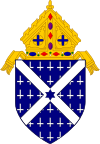Subiaco Academy
| Subiaco Academy | |
|---|---|
| Address | |
 | |
405 North Subiaco Avenue , 72865 United States | |
| Coordinates | 35°18′4″N 93°38′0″W / 35.30111°N 93.63333°W |
| Information | |
| Type | Private, All-Male |
| Religious affiliation(s) | Roman Catholic |
| Established | February 1928 |
| Status | Open |
| CEEB code | 042375 |
| NCES School ID | 00047708[1] |
| Headmaster | Matt Stengel |
| Chaplain | Fr. Brendan Miller, O.S.B. |
| Teaching staff | 21.0[1] (on FTE basis) |
| Grades | 7–12 |
| Gender | Male |
| Enrollment | 193[1] (2015-2016) |
| Student to teacher ratio | 8.2[1] |
| Color(s) | Blue Orange |
| Slogan | America's Best Value in Boarding Schools |
| Sports | Football, golf, cross country, basketball, soccer, tennis, baseball, track and field |
| Mascot | Trojan |
| Team name | Subiaco Trojans |
| Accreditation | Independent School Association of Central States,[2] Arkansas Nonpublic School Accrediting Association[3][3] |
| Newspaper | Periscope |
| Yearbook | Pax |
| Affiliation | Subiaco Abbey |
| Academic Dean | Cheryl Goetz |
| Dean of Men | Greg Timmerman |
| Admissions Director | Pat Franz |
| Athletic Director | Tim Tencleve |
| Website | www |
Subiaco Academy is an American Roman Catholic day and boarding school for boys founded in 1928. It is part of Subiaco Abbey, a Benedictine monastery in Subiaco, Arkansas.
History
The school came into existence as a result of the German migration to the Arkansas River Valley in the 1870s and especially in the 1880s and 1890s. The Little Rock-Fort Smith Railroad Company had thousands of acres of free land in the area. They had resolved to sell this land only to German Catholic settlers if possible. This company approached the Swiss Benedictine Monks in Indiana to send missionaries to Logan County Arkansas in 1878. These monks brought with them their Swiss Benedictine heritage of a monastery school. Until the First World War, numerous additional monks and recruits from Switzerland strengthened this educational tradition.[4]
In 1887 the monks opened a school called St. Benedict's College to educate young men between the ages of 14 and 20 in the basic humanities. There were never more than 20 students in this school and it was terminated in the summer of 1892. The monks reorganized this educational project that summer, and in the fall, the school was reopened as a seminary to train students for the ministry. This school was called The Scholasticate. Modeled upon European "Gymnasium" lines, it consisted mostly of classical languages and musical training. This form of the school reached its peak with some 70 students in 1901 when the institution was largely destroyed by fire.[4]
In December 1927, the institution was again destroyed by fire, but a primitive school, Subiaco Academy, was reopened in February 1928, in what was left of the Main Building. This school barely survived the Depression Years.[4]
The earliest administrators and teachers were all Benedictine monks. By the time of the First World War, there were one or two male lay teachers. Hired coaches were added after the mid-1920s. The great number of non-monk staff (teachers and administrators), including female faculty members, came only in the mid-1970s.[4]
Notable alumni
- John Adams, Professional football player for the Washington Redskins[5]
- Frank Stanford (1966), poet[6]
- Harvey Wheeler (1937), author, political scientist, and scholar [7]
References
- ^ a b c d "Search for Private Schools – School Detail for Subiaco Academy". National Center for Education Statistics. Institute of Education Sciences. Retrieved 1 April 2013.
- ^ "Subiaco Academy". Independent Schools Association of the Central States (ISACS). Retrieved 1 April 2013.
- ^ a b "Member Schools". Arkansas Non-public Schools Accrediting Association. Retrieved 1 April 2013.
- ^ a b c d Assenmacher, Hugh (1977). A Place Called Subiaco: A History of the Benedictine Monks in Arkansas. Little Rock, Ark.: Rose Publishing Company. ISBN 9780914546160.
- ^ http://www.pro-football-reference.com/players/A/AdamJo20.htm
- ^ http://www.poetryfoundation.org/article/181083
- ^ http://www.subiacoacademy.us/index.cfm?load=photoalbum&album=120
External links
- Benedictine secondary schools
- Boarding schools in Arkansas
- Boys' schools in the United States
- Educational institutions established in 1928
- Private middle schools in Arkansas
- Private high schools in Arkansas
- Roman Catholic secondary schools in Arkansas
- Roman Catholic boarding schools in the United States
- Schools in Logan County, Arkansas
- Roman Catholic Diocese of Little Rock
- Preparatory schools in Arkansas

